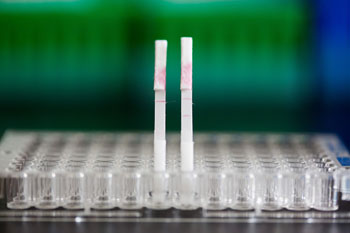Nano-Based Urine Test to Enable Low-Cost Point-of-Care Cancer Diagnosis
By LabMedica International staff writers
Posted on 05 Mar 2014
A simple, noninvasive paper strip-urine test using nanoparticle technology could help transform worldwide screening for cancer and other diseases.Posted on 05 Mar 2014
Massachusetts Institute of Technology (MIT; Cambridge, MA, USA) engineers have developed a simple, inexpensive, paper test. The urine sample based assay, which works like a pregnancy test, could reveal within minutes whether a person has cancer. This approach has helped detect infectious diseases, and the new technology would enable some noncommunicable diseases to be detected using the same strategy.

Image: Simple, low-cost paper-strip assay – novel urine test reveals the presence of proteinases associated with cancer (Photo courtesy of Bryce Vickmark and MIT).
The technology, developed by a team led by MIT professor Sangeeta Bhatia, relies on nanoparticles designed to interact with abnormally upregulated proteases from growing tumors, where each protease can trigger release of hundreds of synthetic molecular biomarkers easily detectable in a patient’s natural, unprocessed urine. Prof. Bhatia and colleagues had developed the technology to thus amplify "signals" from tumor matrix metalloproteinases (MMPs), which facilitate the spread of cancer cells from their original site by cutting through proteins of the extracellular matrix, which holds the cells in place. The MIT nanoparticles are coated with peptides targeted by different MMPs. The nanoparticles congregate at tumor sites, where tumor MMPs cleave hundreds of the coating peptides, which are excreted in the urine.
“When we invented this new class of synthetic biomarker, we used [mass spectrometry] to do the analysis,” says Prof. Bhatia; “For the developing world, we thought it would be exciting to adapt it instead to a paper test that could be performed on unprocessed samples in a rural setting, without the need for any specialized equipment. The simple readout could even be transmitted to a remote caregiver by a picture on a mobile phone.” The team adapted the particles so they could be analyzed using the simple lateral flow assay (LFA), as in pregnancy tests. Detection is by sandwich immunoassay – nitrocellulose paper strips are coated with antibodies to the peptides, as the antibody-captured peptides flow along the strip they are exposed to several invisible test lines made of other antibodies specific to different tags preattached to the peptides. Also, the capture antibody specificity allows the probes to be multiplexed in vivo and quantified simultaneously by the paper lateral flow assay or by ELISA.
This technology can easily be modified to detect multiple types of peptides released by other types or stages of disease. “This is a clever and inspired technology to develop new exogenous compounds that can detect clinical conditions with aberrantly high protease concentrations,” said Samuel Sia, associate professor of biological engineering at Columbia University (not involved in the research); "Extending this technology to detection by strip tests is a big leap forward in bringing its use to outpatient clinics and decentralized health settings.”
“This is a new idea — to create an excreted biomarker instead of relying on what the body gives you,” said Prof. Bhatia. In mouse models, this method accurately identified colorectal solid tumors, as well as thrombosis blood clots. A grant from MIT’s Deshpande Center for Technological Innovation will help fund clinical trials and commercializing the technology. It would likely first be applied to high-risk populations, such as people who have had cancer previously or a family member with the disease.
Prof. Bhatia said she would like to see it eventually used throughout developing areas, but such technology could in many cases also be used in more developed areas as a simple and inexpensive alternative or complement to more expensive advanced diagnostics. Such “point-of-care, image-free cancer detection [...] could really be transformative,” said Prof. Bhatia. With the current version, patients would first receive an injection of the nanoparticles, then urinate onto the paper test strip. The team is now working on a nanoparticle formulation that could be implanted under the skin for more convenience and for longer-term monitoring. The team is also working to identify signatures of MMPs that could be exploited as biomarkers for other types of cancer, as well as for tumors that have metastasized.
The assay is described by Warren et al. in the journal Proceedings of the National Academy of Sciences of the United States of America (PNAS), ahead of print Feb. 24, 2014.
Related Links:
Massachusetts Institute of Technology













